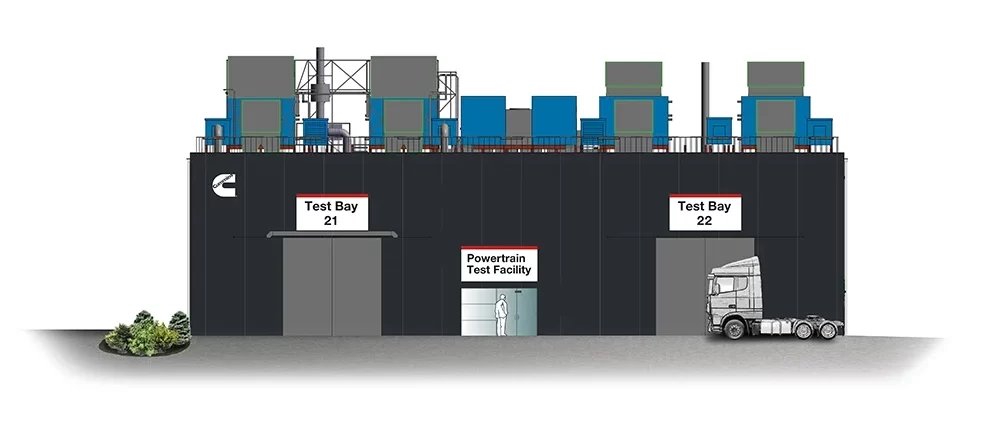Cummins announced it will open a new Powertrain Test Facility at the Darlington, U.K. campus to help accelerate the move towards cleaner, next-generation power technologies focused on reducing greenhouse gas emissions and improving air quality. Ground preparation work for the new facility is now underway with the first phase of the € 16 million (£14 million) investment expected to open for operations by May 2023.

The facility is designed to be fuel-agnostic and will enable Cummins to develop and test a wider range of power technologies, including the latest universal engine platforms with variants able to operate on green hydrogen, renewable natural gas, or sustainable diesel. Installation and testing capability will also extend to hydrogen fuel cell and battery electric powertrains.
Highly advanced dynamometers will be able to test not only powertrains but also chassis-installed powertrains and vehicles, extending in size from a compact SUV to heavy trucks over 44-tons or a double-deck bus. Off-road equipment, including construction machines and agricultural tractors, will also be able to be dyno-tested.
“We are very excited to announce this significant investment in the new Powertrain Test Facility at Darlington, which will be an important element in Cummins Destination Zero strategy to deliver a broad portfolio of power solutions to meet the world’s sustainability challenges,” said Jonathan Atkinson, Executive Director of Cummins On-highway Business in Europe.
“The new facility will further enhance the ability of Cummins European Technical Operations to introduce low-to-zero carbon power solutions and meet the forthcoming Euro VII very low emission regulations, likely to take effect around 2025,”
Cummins’ focus on developing next generation, clean power aligns with the vision of the Tees Valley region to become a leader in alternative power production and technologies. Tees Valley Mayor, Ben Houchen, commented,
“It’s brilliant news that Cummins is set to invest £14 million into their Darlington plant to build a new Powertain Test Facility. Teesside’s leading position as ground zero for net zero means there is no better place to develop the cleaner, healthier, and safer technologies of the future.”
“We’ve already seen how Cummins’ position at the forefront of developments into hydrogen engines is securing hundreds of jobs at their facility and this new investment is another great example of how they are creating, even more, good-quality, well-paid jobs by developing and pushing forward net-zero innovation in Teesside.”
Upskilling to develop clean power technologies
The Cummins Darlington campus co-locates manufacturing, technical, testing, and business services on a single site with around 1,500 employees. The establishment of the new Powertrain Test Facility will provide opportunities to upskill current employees as well as recruitment and training of new employees.
Automotive National Officer for Unite, Steve Bush, said, “Today, Unite welcomes the huge investment by Cummins into the Darlington plant that will create and provide an exciting opportunity for the current workforce to upskill, as well as creating high quality and skilled jobs.” Bush added,
“It is clear that Cummins is at the forefront of the JUST initiative, the transition towards a climate-neutral economy in a fair way that leaves no one behind, and I urge government to support them in their efforts to fully transition. Manufacturers like Cummins must be supported with an industrial strategy, that not only allows development but also shows global leadership in this area. Unite looks forward to supporting Cummins in this new era for manufacturing. Credit must be paid to the hard working, dedicated and committed workforce at Cummins.”
Self-generating sustainable power
Covering a 738 square metre footprint, the two-story Powertrain Test Facility will significantly increase testing capacity with state-of-the-art capabilities at the Darlington campus. The new facility will not only help develop clean power solutions, but also generate its own sustainable power.
The heavy-duty dynamometers and test cells will feature energy recovery systems to generate electricity. This will be exported to the ring main of the Cummins site, adding further capability for energy self-generation on-site. In addition, water consumption of the cooling towers will be reduced by harvesting rainwater, using a similar system already in place at the manufacturing plant.


 Copyright 2017-2025 All rights reserved.
Copyright 2017-2025 All rights reserved.